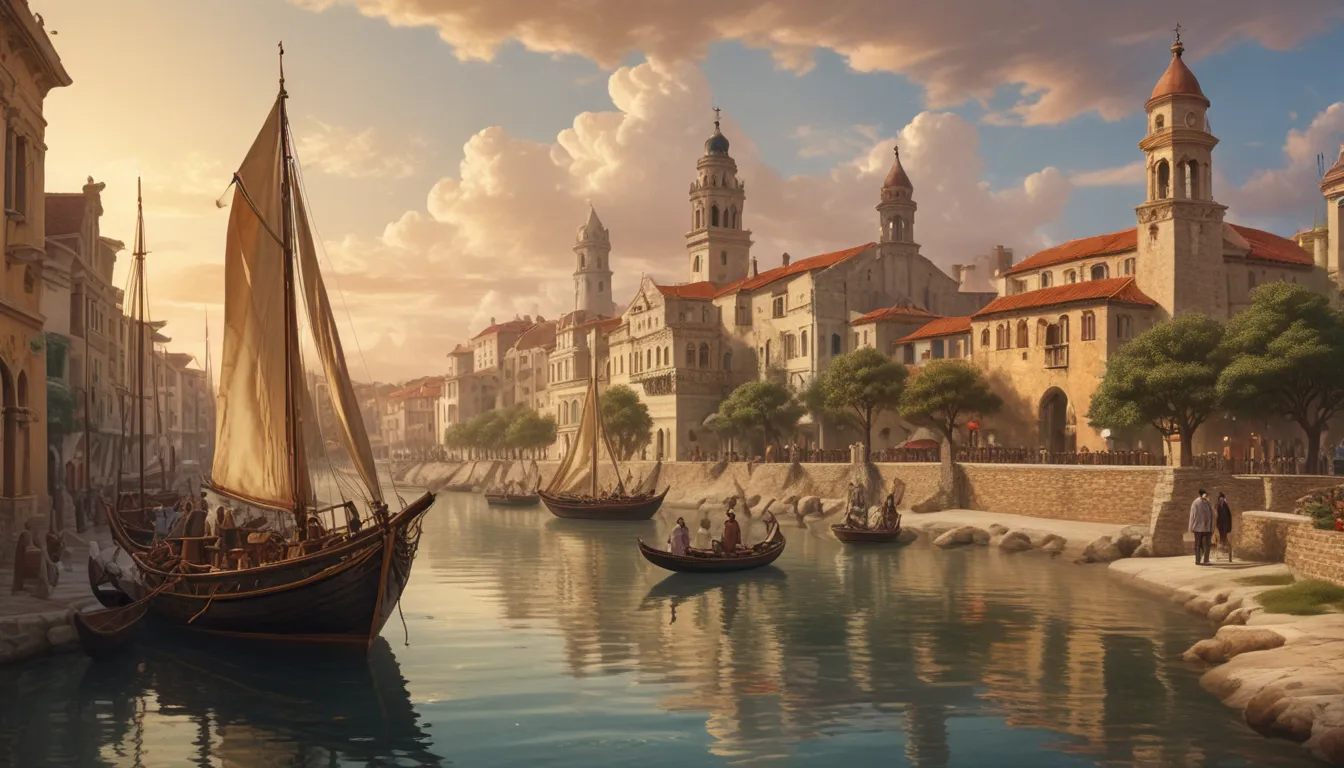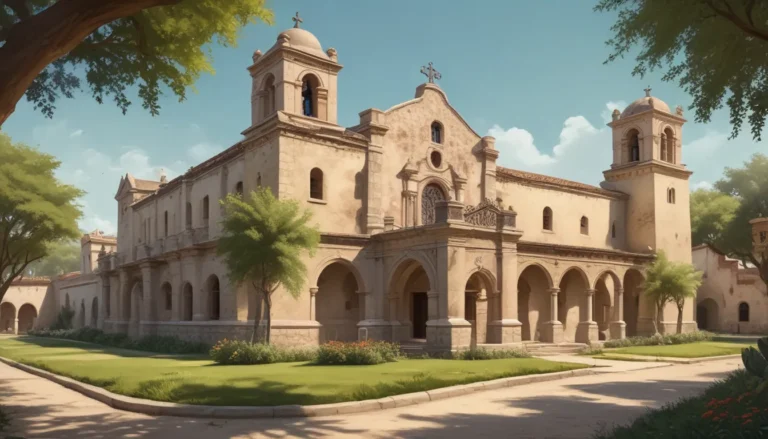The images in our articles may not match the content exactly. They are used to grab your attention, not to show the exact details in the text. The images complement the text but do not replace it.
Welcome to the enchanting world of St. Augustine, the oldest city in the United States, where history comes alive and every cobblestone street whispers tales of the past. From its founding in 1565 by Spanish explorers to its enduring legacy as a cultural and architectural gem, St. Augustine beckons visitors to delve into its captivating stories and timeless allure. In this article, we will embark on a journey through 20 amazing facts about St. Augustine, shedding light on its pivotal role in shaping the landscape of American history. Join us as we unravel the enigmatic charm of this historic city, a living testament to the enduring spirit of exploration and cultural exchange.
A Glimpse into History: St. Augustine’s Rich Legacy
St. Augustine proudly holds the title of the oldest continuously inhabited European settlement in the United States, a testament to its rich history and captivating landmarks that make it a must-visit destination for history enthusiasts and curious travelers. The city’s cobblestone streets and well-preserved architecture offer a glimpse into the past, transporting visitors to a bygone era of Spanish colonial rule. From the iconic Castillo de San Marcos to the Oldest Wooden Schoolhouse, St. Augustine’s historical tapestry is woven with stories of resilience and cultural significance.
Stepping Back in Time: Colonial Charm and Architectural Marvels
Nestled within the heart of St. Augustine lies the oldest wooden schoolhouse in the United States, an architectural gem that provides a captivating insight into the educational practices of yesteryears. Constructed in the early 18th century, this well-preserved structure stands as a testament to the city’s enduring legacy and offers a fascinating juxtaposition to modern-day learning institutions. As visitors wander through the streets of St. Augustine, they are greeted by a harmonious blend of colonial charm and architectural marvels that speak to the city’s storied past and cultural heritage.
Discovering the Mythical Waters: The Fountain of Youth Archaeological Park
The Fountain of Youth Archaeological Park in St. Augustine is a renowned historical attraction, steeped in myth and legend. Visitors can explore the park’s lush grounds, archaeological exhibits, and witness the fabled spring, believed to possess rejuvenating properties. This iconic landmark has been a source of intrigue for centuries, drawing visitors from far and wide to experience the allure of its mythical waters and delve into the mysteries of the past.
Ascending to New Heights: The St. Augustine Lighthouse Experience
Perched on the northern end of Anastasia Island, the St. Augustine Lighthouse stands as a beacon of maritime history, offering breathtaking views of the city and its coastal landscape. Climbing the 219 steps to the top rewards visitors with panoramic vistas that showcase the city’s historical significance and natural beauty. The lighthouse serves as a reminder of St. Augustine’s maritime legacy and its enduring connection to the sea, inviting visitors to explore its rich nautical heritage.
Journeying Through Time: The Colonial Quarter Experience
The Colonial Quarter in St. Augustine invites visitors to step back in time and immerse themselves in the city’s colonial past. With meticulously recreated buildings, interactive experiences, and engaging demonstrations, this living history museum offers a glimpse into the daily lives and cultural influences that shaped the city’s early years. From blacksmith demonstrations to musket drills, the Colonial Quarter provides a hands-on exploration of St. Augustine’s vibrant heritage and colonial roots.
Exploring Living History: The Oldest House in St. Augustine
Constructed in the early 1700s, the González-Alvarez House, also known as the Oldest House, stands as a living testament to St. Augustine’s enduring heritage. This well-preserved abode provides a captivating glimpse into the daily lives of the city’s early residents, showcasing the architectural and domestic facets of colonial Floridian life. As visitors wander through its historic halls, they are transported to a bygone era of Spanish colonial rule, where time seems to stand still.
Unraveling Pirate Lore: The St. Augustine Pirate & Treasure Museum
Immerse yourself in the swashbuckling world of pirates at the St. Augustine Pirate & Treasure Museum, where authentic artifacts and interactive exhibits bring maritime history to life. This captivating museum showcases the golden age of piracy and seafaring adventures, inviting visitors to explore the mysteries of the sea and the legends of the past. From treasure chests to shipwreck artifacts, the museum offers a thrilling glimpse into St. Augustine’s maritime heritage and the daring exploits of pirates.
Embracing Diversity: St. Augustine’s Role in the Civil Rights Movement
St. Augustine’s pivotal role in the Civil Rights Movement is etched in history, with landmark events and peaceful protests shaping the city’s narrative of resilience and activism. Activists like Dr. Robert B. Hayling played a significant role in the fight for racial equality, contributing to the broader struggle for civil rights in the United States. The city’s legacy as a hub of social change and progress continues to inspire visitors and residents alike, highlighting the importance of unity and compassion in building a brighter future.
Delving into the Supernatural: St. Augustine’s Haunted History
With its centuries-old structures and storied past, St. Augustine has earned a reputation as a city with a haunted heritage. From ghostly apparitions to guided ghost tours, the allure of the city’s supernatural narratives adds an intriguing layer to its historical tapestry. As visitors meander through the cobblestone streets, they may catch a glimpse of the city’s spectral residents and uncover the eerie secrets that lie hidden in the shadows.
Celebrating Cultural Heritage: St. Augustine’s Connection to Spanish Colonial Architecture
The architectural landscape of St. Augustine pays homage to its rich heritage and enduring ties to Spanish colonial influences. From coquina structures to ornate balconies, the city’s distinctive aesthetic reflects centuries of cultural exchange and architectural ingenuity. Visitors marvel at the intricate details of Spanish design, which have left an indelible mark on St. Augustine’s skyline and cultural identity.
Honoring Indigenous Roots: St. Augustine’s Role in Timucua History
The area surrounding St. Augustine is steeped in Timucua indigenous history, with archaeological findings shedding light on the ancestral roots of the region. The presence of Timucua artifacts and historical sites serves as a reminder of the indigenous communities that once thrived in the area, highlighting the rich cultural heritage that continues to shape St. Augustine’s identity.
Unearthing the Past: St. Augustine’s Intriguing Archaeological Discoveries
St. Augustine’s archaeological landscape is a treasure trove of historical artifacts and remnants that offer a glimpse into the city’s multifaceted past. Ongoing excavations and discoveries contribute to a deeper understanding of St. Augustine’s evolution, providing valuable insights into its early settlements and cultural influences. From ancient relics to colonial remnants, each discovery adds a layer of complexity to the city’s historical narrative, inviting visitors to uncover the mysteries of the past.
Embracing Arts and Culture: St. Augustine’s Vibrant Scene
Beyond its historical allure, St. Augustine boasts a vibrant arts and culture scene, with galleries, live performances, and cultural events enriching the city’s dynamic tapestry. From contemporary art exhibitions to traditional performances, St. Augustine’s cultural offerings provide a captivating complement to its rich historical narrative. Visitors can immerse themselves in a world of creativity and expression, where the city’s artistic spirit thrives alongside its storied past.
Navigating Maritime Traditions: St. Augustine’s Enduring Connection to the Sea
As a coastal city with a legacy of maritime heritage, St. Augustine’s ties to seafaring traditions are deeply ingrained in its identity. Waterfront landmarks, maritime museums, and nautical monuments serve as reminders of the city’s seafaring past and enduring relationship with the sea. Visitors can explore St. Augustine’s maritime legacy, from historic ships to lighthouse keepers’ tales, and gain a deeper appreciation for the city’s connection to the waters that surround it.
Preserving Historical Treasures: St. Augustine’s Commitment to Conservation
St. Augustine’s dedication to preserving its historical landmarks and cultural heritage is evident in the meticulous restoration and maintenance of iconic sites. The city’s commitment to conservation ensures that future generations can continue to experience and appreciate its rich history and architectural legacy. By safeguarding its historical treasures, St. Augustine ensures that its legacy will endure for years to come, offering a window into the past for generations yet to come.
Shaping Cultural Identity: St. Augustine’s Influence on Florida’s Tapestry
The cultural imprint of St. Augustine extends far beyond its city limits, shaping the broader cultural identity of Florida and contributing to the state’s rich heritage. From culinary traditions to artistic expressions, the city’s historical legacy continues to influence and enrich the cultural fabric of the Sunshine State. Visitors can explore the interconnected histories of St. Augustine and Florida, discovering how each has influenced the other in a vibrant tapestry of cultural exchange and diversity.
Embracing Exploration: St. Augustine’s Spanish Explorers and Conquistadors
St. Augustine’s foundational ties to Spanish explorers and conquistadors highlight its integral role in the age of exploration and colonial expansion. The city’s narrative intertwines with the broader saga of European exploration, creating a compelling story of discovery and cultural exchange. Visitors can trace the footsteps of early explorers and conquerors, uncovering the intricate tapestry of history that defines St. Augustine’s identity as a city of exploration and adventure.
Sustaining Architectural Heritage: St. Augustine’s Commitment to Preservation
St. Augustine’s dedication to architectural preservation is evident in the meticulous care of its historic structures and landmarks. By safeguarding its architectural treasures, the city ensures that its unique heritage remains a vibrant and integral component of its identity. Visitors can admire the intricate details of St. Augustine’s architecture, from colonial facades to ornate courtyards, and appreciate the city’s commitment to preserving its architectural legacy for future generations to enjoy.
Embracing Historical Narratives: St. Augustine’s Multifaceted Tapestry
The historical narratives of St. Augustine encompass a rich tapestry of cultural influences, societal dynamics, and pivotal events that have shaped the city’s identity. From colonial encounters to modern reflections, the city’s historical depth offers a captivating exploration of the human experience across different epochs. Visitors can delve into the multifaceted stories of St. Augustine, appreciating the city’s diverse heritage and the enduring legacy that continues to resonate through its streets and landmarks.
Rediscovering Timeless Allure: St. Augustine’s Enduring Legacy
St. Augustine’s enduring legacy as a historical gem resonates through its captivating landmarks, vibrant narratives, and immersive experiences. As the oldest city in the United States, it continues to enthrall visitors with its timeless allure and rich tapestry of historical significance. With its immersive attractions, diverse narratives, and architectural splendor, St. Augustine stands as a living testament to the enduring spirit of history and the human experience.
In conclusion, St. Augustine is a city that captivates the imagination with its rich history, architectural wonders, and cultural richness. From its status as the oldest city in the United States to its pivotal role in shaping American history, St. Augustine invites visitors to embark on a journey through time and heritage. By exploring the city’s fascinating facts and landmarks, one gains a deeper appreciation for its enduring legacy and the profound impact it has had on the cultural landscape of America.
FAQs About St. Augustine
Q: What makes St. Augustine historically significant?
A: St. Augustine is the oldest continuously inhabited European settlement in the United States, dating back to 1565.
Q: What are some must-see historical landmarks in St. Augustine?
A: Visitors should explore iconic sites like the Castillo de San Marcos, the Oldest Wooden School House, and the St. Augustine Lighthouse & Maritime Museum to immerse themselves in the city’s rich history and architectural marvels.
As you journey through the historic streets of St. Augustine, each step unveils a new chapter in the city’s compelling narrative. Whether you are drawn to its haunted history, architectural splendor, or cultural vibrancy, St. Augustine offers a tapestry of experiences that celebrate its enduring legacy and timeless charm. Join us in exploring this remarkable city, where the past is alive and the stories of generations past continue to resonate through its streets and landmarks.






